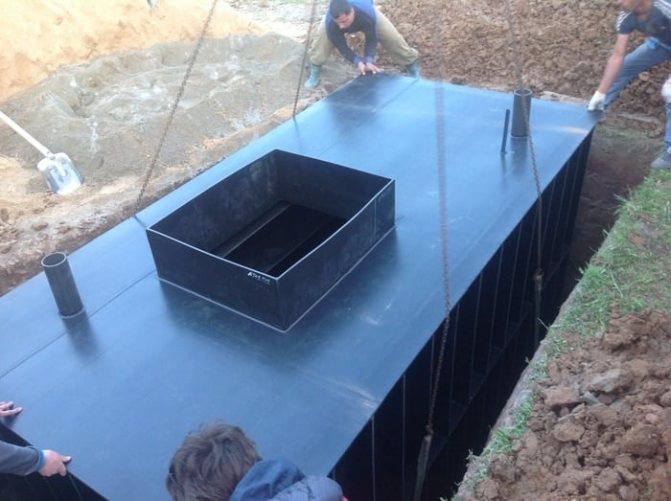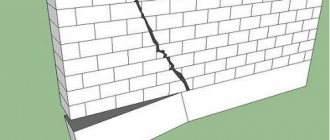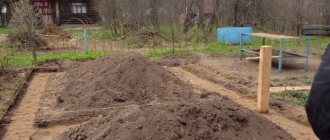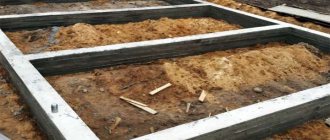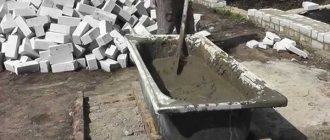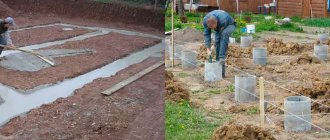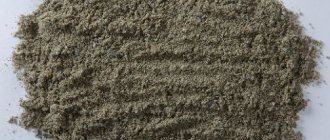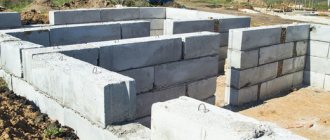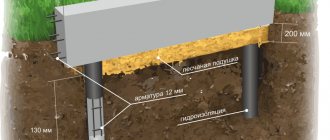Our well-being depends on what we use every day for drinking and cooking. We need a liquid that is close in composition to ideal, regardless of the method of production. One option is to obtain the liquid from underground sources. Let's try to understand what groundwater is and how the groundwater level of an area is determined.
Definition
Depending on the intensity of precipitation, the geological characteristics of the area, the time of year, the proximity of natural bodies of water and a large list of reasons, wet soil may appear at different depths when digging a well. This definition includes the first stable aquifer. It is located above the clay in the sand area. The main source of replenishment of this resource is rain, snow melting, and flowing streams from mountain peaks. It is worth separating two main problems - the ability of the soil to heave, which greatly affects the characteristics of the foundations of the building, and another important factor - the size of the well and its productivity.
Characteristics and chemical composition of groundwater
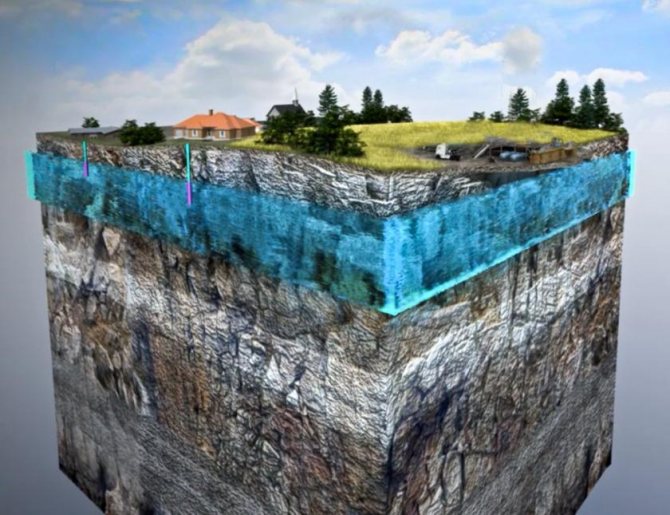
The most necessary indicators are abundance and detachment from the weather. In this regard, such sources are not stable. The difference can reach twenty meters, fluctuating not only with an annual cycle, but also with a periodicity of 10 years or more. Changes that are irreversible are possible, both for the better and for the worse. This occurs due to changes in the paths of underground flows. Many people know that near rivers, lakes, and on slopes, the depth of occurrence can be many times greater than on flat terrain. Such layers are replenished mainly due to the seepage of sediments from above. Along the way, the underlying rocks dissolve. Since the composition of minerals can change quite seriously, the dissolved impurities in such a source are varied. They change rapidly from point to point.
Penetrating through the fertile layers, water takes with it the products of biological activity. These are mainly nitrates and nitrites. Touching limestone deposits, it is enriched with calcium and magnesium. Close to the surface there are underlying fossils with a wide variety of chemistry, and everything that can dissolve ends up in the liquid. Therefore, the quality of such a source is often low and requires additional steps to improve safety and eliminate unwanted impurities.
Bulk cellar
It is not so difficult to build a bulk cellar with your own hands if the groundwater level is high. It is better to choose an elevated location, as far as possible from the nearest body of water. The entrance is best oriented to the north.
How to build a bulk cellar with your own hands if the groundwater is close to the surface:
- Construction should begin by clearing the site and removing the top layer of soil. It is advisable to deepen the base of the cellar to a depth not exceeding 50 cm.
- Level the bottom of the basement, lay a mixture of sand and crushed stone, compact it and fill it with bitumen. This will give the necessary waterproofness to the floor. You can use other waterproofing materials.
- Build walls from bricks, blocks or wood. The inside and outside of the walls are also covered with bitumen or other material to protect against moisture. Arrange an entrance opening.
- Mount the basement roof from boards or timber 40-50 mm thick, treated with special compounds to prevent rotting. Additionally cover with a layer of bitumen.
- The outside of the entire structure is treated with bitumen and covered with roofing felt in 2 layers.
- Install thermal insulation from clay or mineral wool.
- Cover the entire building with a layer of earth - 70-120 cm, with a sufficient clay content, and give the structure the shape of a hill.
- Carry out final work on installing doors and interior decoration.
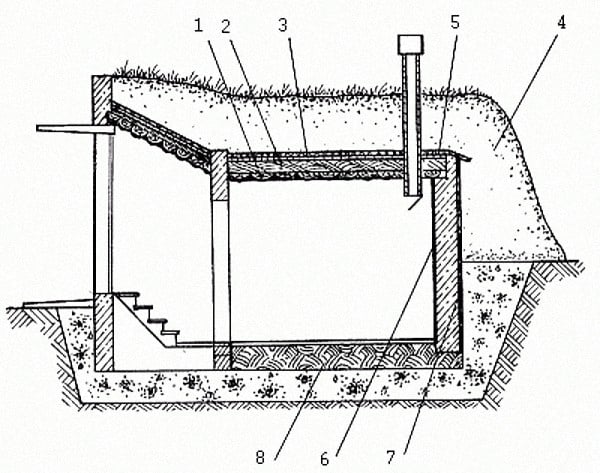
Types, types and characteristics of groundwater

The main feature of such sources is their occurrence above an impermeable layer. They are divided into:
- Plast. Formed in sandstones and other permeable soils.
- Cracked. So named because the liquid fills the natural results of the destruction of solid layers that are not prone to dissolution.
- Porous. Creates an extensive network of small containers in a monolith subject to leaching (limestones, dolomites, chalk).
From this it is clear that the most abundant layers can be found in areas with large masses of sedimentary rocks located above impermeable clay or rock fields. Geology is usually very nonlinear, and underground there are both entire “lakes” formed by underlying soils and stable areas with constant movement of fluid (slopes). Due to this, the efficiency of drilling wells can vary greatly at a short distance from each other.
What are the risks of construction in areas with difficult soil?
High groundwater levels, unstable soil and unfavorable soil composition can significantly increase the cost of building a house, because you will have to use quite specific and expensive construction technologies.
You should be prepared for the fact that in such areas the cost of foundation construction, waterproofing, design, as well as landscaping work associated with strengthening the site will be much more expensive.
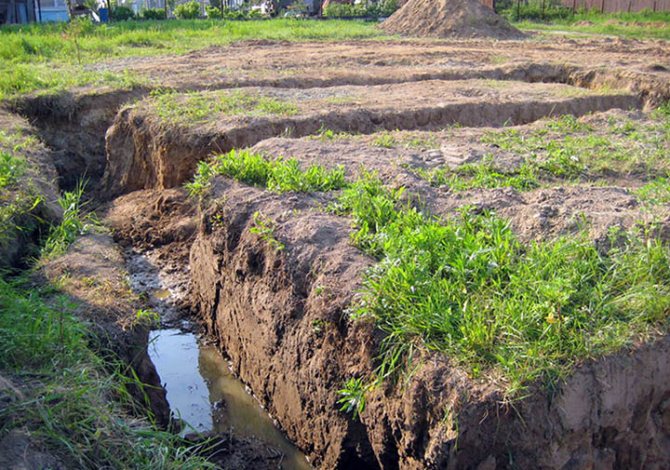
Therefore, if, when inspecting the site, you have even slight doubts about the suitability of the soil for construction, you always have 2 options:
- abandon the purchase and move on to inspecting other objects;
- or start exploring the site, order a geological examination and make a final decision.
Geological surveys are not cheap, but if this is not done, the consequences of improper construction, possible landslides, cracks in the building and even the destruction of the house will cost you much more.
So it's up to you. But if you are going to build a house on a site with difficult soil, or if you are planning to build a house with a basement or ground floor on a site with a high groundwater level, we strongly recommend ordering this service.
Zoning

Depending on the geological conditions and climatic zone, the amount of groundwater may vary. If in forests and tundras the level is very high and there are few dissolved impurities, then in the steppes it is difficult to reach the aquifer. In this case, the springs often have a high degree of salinity.
MBFT-75 Membrane for 75GPD
AMETHYST - 02 M Residential building for up to 10 people or up to 2 cubic meters/day.
Aeration unit AS-1054 VO-90
In rugged terrain, composition and abundance can vary dramatically in small areas. In the mountains, seasonal snow melting, complex terrain and the chemistry of the supporting masses have a huge impact.
In desert and semi-desert areas there may be zones with a complete absence of water-bearing sources during certain periods of time. The existing wells are mostly salty in taste.
In what cases does the level at the site need to be lowered?
Dewatering work is necessary under the following conditions:
- the bottom line of the existing or proposed foundation will be located below groundwater or at a height not exceeding 0.5 m;
- the basement floor will be located at a depth of more than 1.5 meters in soil with a clay or loamy structure;
- the area belongs to the zone of capillary moistening and freezes quite deeply at low temperatures;
- close location of groundwater, the pressure of which exerts critical pressure on the foundation;
- excessive swampiness of the site;
- overmoistening of the site, leading to the appearance of dirt, erosion of the top fertile layer of soil, which makes all agricultural measures ineffective and significantly reduces the chances of obtaining a good harvest.
Where are they used?
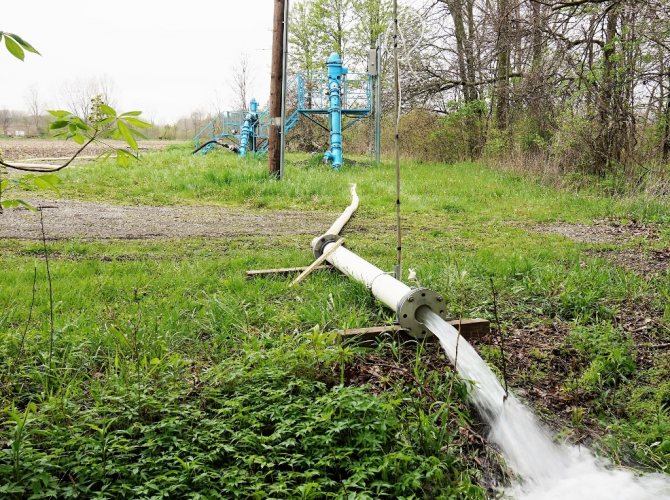
This resource is widely used to meet household needs. In each settlement, a shallow mine is dug near the house to use water in the kitchen and for watering plants. Due to strong differences in taste, housewives prefer to take moisture for cooking from certain points. That is, the chemical composition can be different even on the same street.
In industrial quantities, use is limited due to seasonal level changes and low power. In most cases, the amount of dissolved impurities does not meet the standards. In addition, overly active exploitation can disrupt the natural water balance, and thereby affect the nature of vegetation in the area, since part of the flora receives nutrition from great depths.
How do heated substances affect the base?
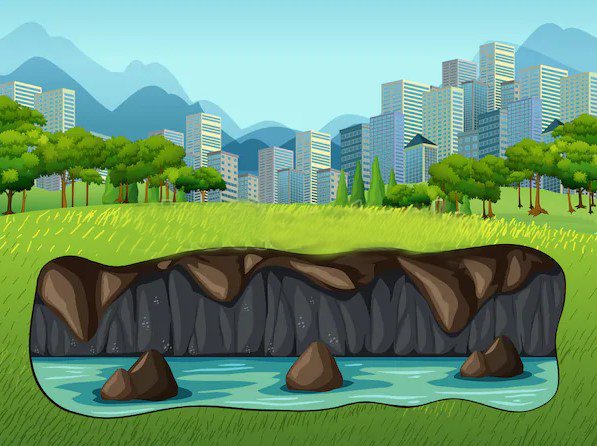
The supporting foundation is clay, loam or rock. If for the latter the chemical composition is usually not very critical, then the water indicator can have a serious impact on sedimentary layers. Dry clay is strong and not prone to deformation. Saturation with liquid leads to an increase in plasticity and a sharp decrease in load-bearing properties. As an example, seasonal muddy roads in central Russia.
A fairly common phenomenon is karst cavities formed when precipitation penetrates into the limestone zone. Such caves (which have lost their strength over time) are capable of “absorbing” entire high-rise buildings.
Aggressiveness
Its chemical composition also depends on where the groundwater is located. If a pure liquid has fairly predictable properties and its effects are easy to resist, then dissolved salts, acids and other trace elements seriously change the activity of the solution. Because of this, the corrosion properties and dissolving abilities differ. This must be taken into account when constructing buildings and communications.
In temperate climate zones, serious attention is paid to the freezing properties of soils saturated with water. Since the forces arising in this case are very large and can destroy the concrete foundation or deform the steel pipe in the freezing area.
Calcium and magnesium impurities tend to settle on metal and other surfaces when heated. This threatens to quickly destroy expensive equipment. Therefore, it is necessary to use a cleaning system. The quality of the liquid can be very different and prone to seasonal changes. You can pick up a filter kit in a specialized one. After processing, all characteristics will return to normal.
Installation of a drainage system in areas with high groundwater levels
The construction of foundations, the base of which is supposed to be built below the groundwater level, inevitably leads to the use of various methods of water reduction. In other words, options are selected for removing water from a pit or trenches and keeping it at a certain distance.
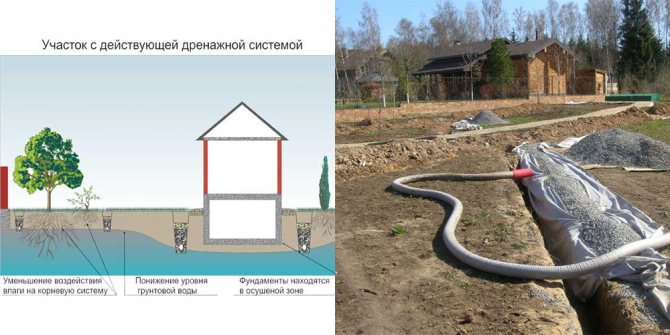
Installation of a drainage system
Drainage involves the removal of melt and groundwater. To equip the system, drainage pipes, wells, channels, pumps and much more are used.
There are 2 ways to install a drainage system.
Open depression
You can pump out water with a drainage pump, but in this case certain conditions must be met:
- There is a reservoir nearby where the pumped water will flow.
- No visible signs of suffusion. With this phenomenon, the smallest particles of soil are carried away along with water, which leads to subsidence of the soil layers located above. The bearing capacity of such soils is very low due to constant subsidence.
Also, the open dewatering system involves a simplified version of the disposal of melt, ground and storm water. To organize such a process, it is necessary to place drainage ditches around the perimeter of the site. Water of various origins flows into them for one reason: the absence of soil resistance and capillary rise of liquid. Such systems are most effective if the site is located on a slope.
Closed drainage system

Closed drainage
Closed drainage helps drain groundwater, thereby preventing it from rising. The basis of the system is underground pipes. A closed drainage is a carefully planned structure of pipes and wells. The system is located in a trench, the bottom of which is covered with sand and crushed stone, and also covered with geological fabric. Pipes of a closed drainage system are laid under groundwater. The top is covered with an additional layer of sand and crushed stone, which helps drain water. The entire system is covered with soil and a layer of turf.
How does gas extraction take place?
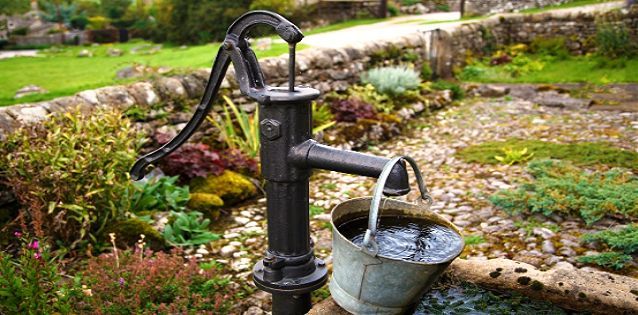
Main table dispenser AquaPro 919H/RO (hot and cold water)
Main table dispenser AquaPro 929CH/RO (cooling/heating)
Floor dispenser AquaPro 311 (empty, without cooling)
Depending on the depth and purpose of use, different methods are used. The most common is digging and building a regular well. Such an object becomes an attribute of any rural landscape. The advantages of this method are relative simplicity and sufficient source resources.
Recently, wells have become very popular. This is cheaper, does not require the creation of casing structures, but at the same time, there is a reduced volume of liquid dispensed.
On slopes and lowlands this resource often comes to the surface. The Central Russian Plain is replete with small springs, which are natural outlets of hot water. In such cases there is no need to make any structures.
Purity
Recently, people have begun to think about the quality of water in the upper layer at the state level. Due to the high intensity of economic activity, the most exotic pollutants penetrate into the springs. As a result of the work of agricultural enterprises, fertilizers, pesticides and decomposition products from farms enter it. Industrial pollutants are considered more dangerous, since they are difficult to process naturally and contain salts of heavy metals. One of the problems is the presence of protozoan microorganisms and viruses. Thanks to organic matter and oxygen, water from wells and springs has a large number of bacteria.
Determination of groundwater level
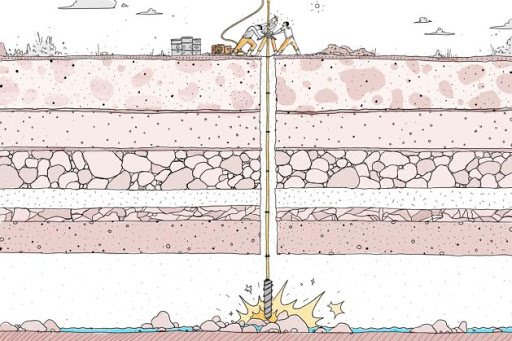
This indicator has a fairly serious impact on the characteristics of sources and the parameters of foundations during construction. Let's look at what it consists of and how it is assessed. If the lower boundary is determined by the depth of the underlying impervious surface (clay, loam, rock), then the upper boundary is subject to fluctuations and depends on many factors.
Maximum forecast ground level
This value is very important when carrying out design work before the construction of structures. Geological exploration is carried out during the period of maximum rise (spring, early summer for central Russia; seasonal melting of snow in the foothills, etc.). The minimum depth of water appearance is taken as the control level. The most difficult areas are the salt marsh areas. This is due to the fact that all sources from the surrounding area flow into this area. Here, most of the year, the liquid is close to the surface.
When designing, it is necessary to take into account changes in the parameter from year to year. Because it is strongly tied to the amount of precipitation. It is also influenced by landscape features and rock structure.
Floor-standing dispenser AquaPro 6207CH (cooling/heating/room temp.)
Wall-mounted dispenser AquaPro 3207CH (cooling/heating)
Aeration column AS-0844 VO-90
From experience it follows that the indicator may differ by 0.5 or 1.5 meters or more. Therefore, as a design value, it is customary to consider a value 1 m higher than measured. This allows you to minimize the risk of destruction during the construction of structures.
Capillary rise
When determining what it is - the level of groundwater, this value should not be confused with the depth of appearance of wet soil. Due to wetting, the liquid tends to rise through pores and microcracks. Therefore, already on the first/second bayonet of the shovel you can notice soil moisture. The ability for such behavior is absolutely different among different structures. For example, clean river sand is not prone to capillary conduction of moisture, but fine loam can get wet for several meters. These parameters also need to be taken into account when constructing buildings, since due to impregnation, soils acquire the ability to expand when frozen.
Irrigation works
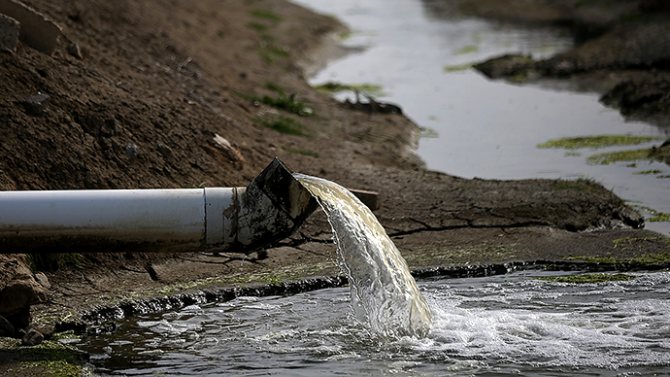
In problem areas, artificial reduction of groundwater level is often practiced. For this purpose, structures are built to speed up the outflow of fluid. These can be drainage channels, drainage systems. A properly created drainage network will help radically solve the problem of too high humidity in the top layer of soil. Such devices have been used for thousands of years and have proven their effectiveness.
The simplest method is to dig a trench into which the excess will be collected. Next, the drainage is carried out into the natural environment (lakes, rivers, ponds, ravines) or into a special storage tank for use for economic needs. This technology is inexpensive, but requires constant maintenance (cleaning, restoration, deepening). In addition, the structures are dangerous and do not decorate the landscape.
Another common method is drainage. An artificial watercourse is laid at the required depth. In this case, the excess is collected from the soil and directed below the surface to discharge points. The design varies and is often combined with municipal wastewater collection systems. Under large megacities there are entire labyrinths that protect the infrastructure from uncontrolled movements of the masses.
In rural areas, within a garden plot, such events do not require large-scale structures and large financial investments. The solution to the problem is achieved by laying drainage pipes or forming water-permeable channels from crushed stone, sand, or expanded clay.
When the water is close. Foundation on difficult soil
October 28 at 18:50 14430 Denis Galochkin
When the plot is purchased, the developer rushes to start designing and begin building the house. But, unfortunately, there are a number of factors that can seriously affect the construction plan. One of them is the high groundwater level. Let's try to figure out what this danger is, what it threatens and, most importantly, how to deal with this bad geological condition.
As a researcher
When purchasing a plot, an inexperienced person may simply not be interested in how close the groundwater is to the surface. This is how classic situations arise when there is no one to blame but yourself. How to be? You should start by getting to know your neighbors in misfortune: asking what materials and technologies they used to build the structures. In addition, you will have to conduct a geological survey to find out the type of soil on the site and the level of surface water. This should be done when the maximum amount of moisture accumulates in the soil - in early spring or autumn after long rains. You should choose a place where a cellar or cesspool will be located in the future (so as not to work in vain) and dig a hole 3 m deep and 1 square meter in cross section. m, cover it with a lid to prevent rainwater from getting inside. After a few days, check the level of accumulated water. If the liquid never appears or is barely visible at the bottom, then groundwater can be ignored during construction. If the moisture rises to a level above 2 m, you will have to seriously think through the design of the foundation.
The construction of a screw pile foundation does not require the use of large equipment, unlike other types of foundations.
The type of soil should also be determined, as this is important when surface water levels are high. From a small area it is necessary to remove a layer of turf and fertile soil, and then extract two handfuls of earth: from a shallow depth (about 200 mm) and from the freezing depth (for Moscow and the Moscow region this figure varies from 1.8 m in the south to 2.5 m in the north). Next, you need to slightly moisten the handfuls and try to roll them in your hands. A sample of clay soil will quickly take shape like plasticine. Cracking of the soil indicates loam, and soil breaking up into separate balls will most likely turn out to be sandy loam. Sand is the easiest to recognize - this crumbling substance cannot be rolled at all. Any type of foundation can be built on coarse sand, while clay (heaving soil) requires serious calculations when choosing a foundation.
Why should we be afraid of surface groundwater at all? Firstly, the salts contained in the water will destroy concrete, and dampness will provoke the appearance of mold on the walls. Secondly, not only the foundation will suffer - the water will reach the basement and basement of the house. Thirdly, water located above the soil freezing level will turn into ice at subzero temperatures, increase in volume and shift soil layers, which will lead to destruction or shifts of the foundation. What kind of foundation can be built under such conditions?
EXPERT OPINION
Vladimir KRYUCHKOV, specialist of the screw supports department, construction
When building a foundation in conditions of high groundwater levels, you may encounter a problem such as cement bacillus, when water with a high content of sulfates destroys and loosens the foundation of the house. Unlike a concrete foundation, screw piles, manufactured in a factory according to specifications, are completely sealed. Ground water can get inside the support only in the case of through corrosion, that is, in fact, at the end of their service life, after about 100–120 years. Increasing the strength and preventing corrosion of piles is also facilitated by pouring a cement mixture into their shaft. Constant contact of screw supports with groundwater will not reduce their service life, since they are designed for operation in critical circumstances. It would be more correct to say that, on the contrary, favorable conditions will extend the service life of the pile foundation. It is worth mentioning that screw supports are often used in reservoirs for the construction of berths, piers, and walkways. At the same time, part of their trunk is constantly in the water. The strength characteristics of the piles are such that no additional protective measures are required to extend their service life.
On chicken legs
The most budget option for a foundation is a pile foundation. It is even suitable for construction on marshy and peat soils. Piles (reinforced concrete, screw or other type) are installed at the location of the future load-bearing walls of the house at the same distance from each other and are buried into the ground below the freezing level of the soil so that the pillars rest on solid, stable layers of soil. From above, the piles are tied into a single contour with a grillage - a concrete strip on which the load-bearing walls will rest. Before this, the upper part of each support must be waterproofed in order to cut off the rise of capillary moisture.
The pile foundation resists frost heaving of the soil well without changing its geometry, and the small volume of excavation work will allow significant savings on its construction, especially if you use TISE - an individual construction technology. It involves manual drilling of a hole under the pile to a depth of 2.5–3 m, followed by reinforcement, installation of a cushion of sand and crushed stone, and pouring with concrete. However, this method requires pre-draining the well before filling it with solution.
When the groundwater level is high, special attention should be paid to waterproofing slab and prefabricated foundations. To cut off moisture, you can use both roll and coating materials - bitumen mastics, waterproofing mixtures.
Pile foundations have a number of disadvantages. The first of them is the impossibility of building a basement or ground floor (there is no base plate and walls for these structures). Second, this type of foundation is more suitable for lightweight houses - frame, wooden, or built from lightweight concrete. Third, the construction of a pile foundation is not always possible, since the heel of each pile must rest on a solid layer of soil. At what depth it is located and whether it exists at all in a particular area, only a specialist can answer.
Over the seas, over the waves
If the construction of a pile foundation is impossible due to the lack of solid load-bearing soil layers, the solution may be to construct a so-called floating foundation. Structurally, it consists of a flat concrete slab of small thickness, laid on a sand cushion. In this case, the weight of the house will balance the heaving pressure of the soil, and in the event of uneven changes in the soil, the slab will behave like a raft on the waves - it will rise or fall without causing deformation of the structure.
To install such a foundation, first mark the area, determining the area to be poured. Then select soil to a depth of 0.4–0.5 m. Having carefully leveled the bottom of the pit, arrange a cushion of sand and crushed stone 0.2–0.4 m thick with mandatory compaction. Then the base is waterproofed by laying rolled material or laying EPS boards, which, in addition to cutting off moisture, will also insulate the structure. After that, along the perimeter of the future foundation, formwork is built from boards, a reinforcing lattice is mounted and filled with concrete mortar M200 or M300, bayoneting each layer. The thickness of the slab is calculated individually for each specific site, since it is necessary to take into account both the type of soil and the weight of the main structure.
Unfortunately, this type of foundation also has disadvantages. Firstly, as in the case of a pile foundation, you will have to forget about the possibility of constructing a basement or ground floor. Secondly, the construction of a floating slab is possible only on an area with a slope of no more than 5°.
Every whim for your money
If you definitely want a house with a spacious basement or ground floor, then a prefabricated foundation is built from reinforced concrete blocks on a support pad (concrete slab). To do this, a pit is dug under the entire future house to a depth below the location of groundwater. It is more advisable to carry out the work in the summer, so that as little moisture as possible accumulates at the bottom of the pit. If the foundation is installed in the fall or spring, walls are built around the perimeter of the pit from buried polymer or metal piles connected to each other with special locks, and the moisture formed at the bottom is constantly pumped out. When the pit is dug, the bottom is carefully leveled and compacted and a footing is poured - a thin leveling layer of concrete mortar. In parallel with it, a drainage system of perforated PVC pipes wrapped in geotextile is installed along the perimeter, which will collect soil moisture and drain it into the drainage well. A layer of rolled waterproofing is laid on the footing, leaving allowances for the walls along the edges. Then formwork is installed around the perimeter of the support cushion, a reinforcing frame is mounted inside it and filled with ready-made concrete mortar. After the slab has gained the necessary strength, the foundation walls are erected - structures made of reinforced concrete blocks are installed under the future load-bearing walls. On the outside they are covered with several layers of rolled waterproofing.
The main disadvantage of such a foundation is its high cost due to the large volume of excavation work and concrete mixture. In addition, errors in the installation of the drainage system or waterproofing can lead to flooding of the basement and wetness of the walls of the building.
To summarize, it should be said that construction in conditions of high groundwater levels is possible, but you should definitely enlist the support of specialists who will accurately determine the geology of the site and perform the correct calculations for the foundation of the future structure. Remember, high surface water is not an obstacle, but merely a condition of construction.
- Discuss
News smi2.ru
Related articles:
- Where and when will there be a new metro station and international bus station in Moscow?
We found out where and when a new metro station and international bus station will be built in Moscow. - When they can take away your apartment for debts
We talked with a lawyer and found out what will happen if you don’t pay the rent and think that no one will take it from you, because it’s yours. - When a fake is better than the original
“To buy something unnecessary, you must first sell something unnecessary.” The wise remark of Matroskin the cat sometimes applies to very necessary things - for example, real estate. The construction boom of recent years has generated an extensive supply on the primary market.
Save your time!
Subscribe to the weekly newsletter and receive the most important real estate news of the past week from market experts
Comments:
Sorry, no comments found.
Disadvantages of the source
The conditions of groundwater occurrence at the site bring their own characteristics both to the efficiency of production and to the quality of the resulting liquid. Wells and boreholes using the first layer do not differ in level stability, and therefore in the possible amount of resource production. Moreover, fluctuations can be not only seasonal, but also annual. When there is an abundance of precipitation, overflow occurs, which is also undesirable. Proximity to the surface does not allow moisture to undergo proper filtration and many impurities of both biological and chemical composition enter the source.
The decomposition products of flora and fauna are enriched with nitrates and microorganisms. By dissolving the rock through which seepage occurs, the liquid becomes clogged with magnesium and calcium salts. There is also a high risk of contamination with industrial products, fertilizers, and pesticides. Therefore, before use it is necessary to use treatment facilities or household filters.
Metal cellar-caisson
A caisson is a chamber or box made of metal or plastic with sides. Sometimes it is made of reinforced concrete, but in the conditions of country house construction this is very expensive. In case of high groundwater, a caisson cellar reliably protects the reserves stored in it.
The caisson, due to the high tightness of the joints, is used even at very high groundwater levels. Before installation, the metal bunker is treated from corrosion on the outside, and the inside is painted with metal paint.
The plastic caisson does not require additional processing. A pipe with a shut-off valve is welded in one of the corners at the bottom of the box. When the caisson is lowered into the pit, the tap opens and water flows into the chamber. After installation, the cellar is secured in the ground by concreting the sides, the water is pumped out and the tap is closed. Install the ladder and manhole cover. To prevent the caisson from floating when the groundwater level rises, it is additionally secured with anchors and equipped with devices for pumping water from under the bottom.
A metal caisson cellar has a lot of advantages that are fully justified by its price.
